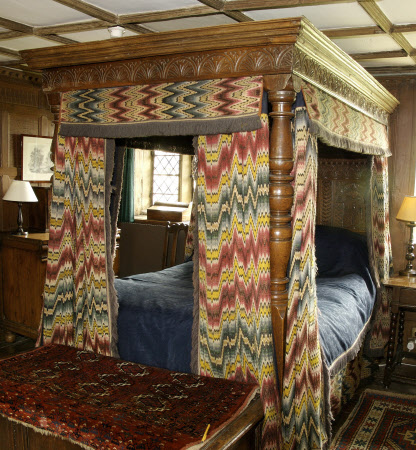Tester bed
Date
circa 1850 - circa 1950
Materials
Oak, Textile, Wool
Measurements
213 x 155 x 22 cm
Order this imageCollection
Westwood Manor, Wiltshire
NT 222367
Summary
Oak tester bedstead, late 19th/20th Century. The headboard ('dorsa') has three panels carved with arches, reversed scrolls, floral motifs and strapwork separated by uprights with guilloche decoration beneath a line of lunettes with a dentil cornice and further lines of carved and chip carved decoration above. It supports a framed and panelled canopy ('tester'), the panels carved, with a moulded cornice and a frieze carved with lunettes, from which hang 3 tester valences and 6 curtains of wool flamestitch needlework with a fringe. The foot-posts have squared bases (heightened) with a single pair of reversed balusters above. Rebuilt cornice and posts 17th Century. Commonly referred to as a 'four-poster' bed this type of course only has two, the headboard providing the rest of the required support. Until the late Middle Ages Best Beds had dorsas and testers of fabric, suspended by cords from the ceiling with more domesticated times after 1485 an actual 'four-poster' did evolve as furniture itself started to have status and become decorated rather than the easily removed and transported fabrics as previously. The headboard of the new bedsteads, initially low, soon grew to make the head posts redundant as carving became more fashionable.
Provenance
E.G. Lister collection
